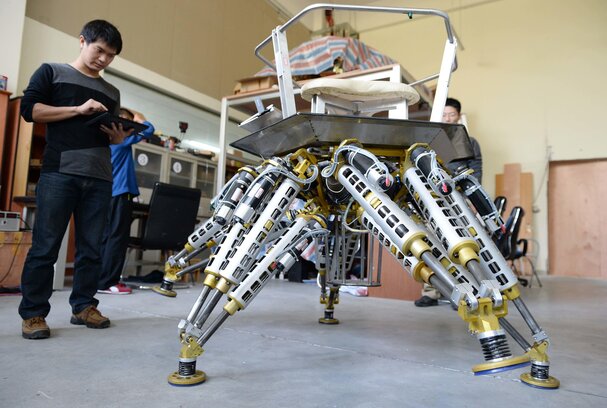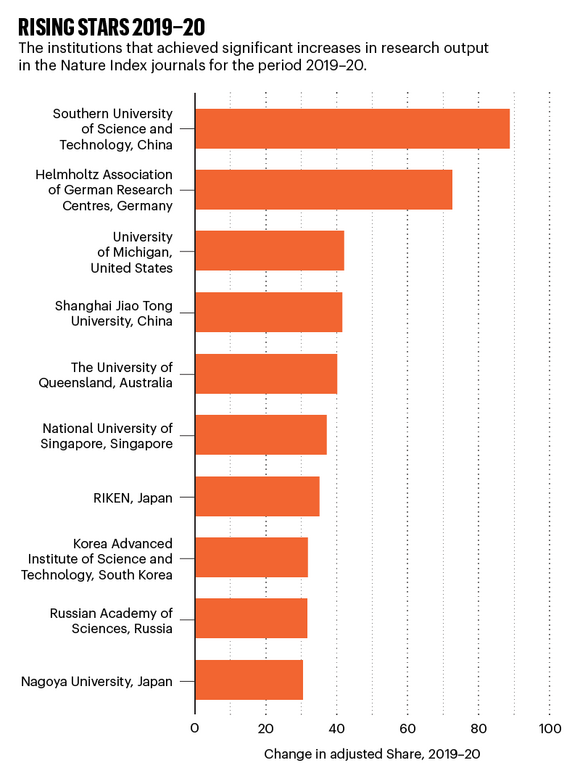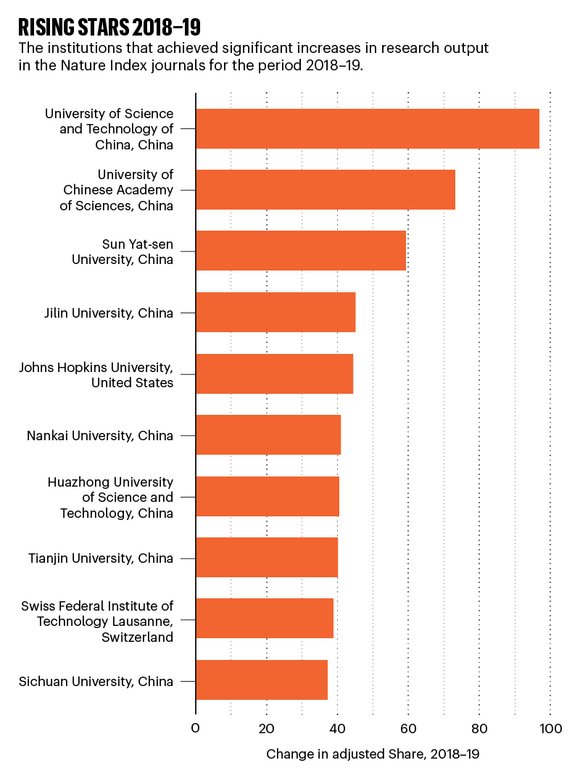
A student remote-controls a six-legged rescue robot at the School of Mechanical Engineering of Shanghai Jiao Tong University, one of the fastest rising institutions in the Nature Index Annual Tables 2021.
Credit: Imaginechina Limited/Alamy Stock Photo
Ten rising stars of the Nature Index Annual Tables 2021
China’s dominance falls away, as this year’s list of fast-risers features a more global spread of institutions.
20 May 2021

Imaginechina Limited/Alamy Stock Photo
A student remote-controls a six-legged rescue robot at the School of Mechanical Engineering of Shanghai Jiao Tong University, one of the fastest rising institutions in the Nature Index Annual Tables 2021.
The rapid growth of several leading Chinese universities in high-quality natural-sciences research output has slowed, according to an analysis of rising stars for the Nature Index Annual Tables 2021.
Only two mainland China institutions make the top ten (see below), a marked difference from previous years.
Institutions from seven other countries appear: Germany, the United States, Australia, Singapore, Japan, South Korea and Russia. The tables take in institutional outputs for the period 2019-2020.

Source: Nature Index
By comparison, in the one-year period 2018-2019, many of the Chinese institutions that featured among the top ten (see below), are absent from the Nature Index Annual Tables 2021 top 50 fastest rising.

Source: Nature Index
Futao Huang, a higher education researcher at the Research Institute for Higher Education at Hiroshima University, Japan, says this could be the result of shifting priorities in China’s academic evaluation system, as the country moves away from a focus on the number of papers published in internationally indexed journals as a key performance indicator.
Since late 2018, the Chinese government has encouraged Chinese universities, research institutes and researchers to focus more on publishing in domestic journals, and for individuals to be judged on this in recruitment, academic promotion, grant applications, and other academic evaluations.
“This is the most important factor affecting the decline in the number of international publications by Chinese researchers in recent years,” says Huang, who expects that the policies will also affect the presence of several Chinese universities in other global university rankings.
Most improved
The fastest rising institution in the Nature Index Annual Tables 2021 is the Southern University of Science and Technology in Shenzhen, part of China’s Guangdong-Hong Kong-Macau Greater Bay Area.
The university, which was established in 2012, gained 88.77 in adjusted Share1 in 2019-2020, more than any other institution in the Nature Index, representing a 66.8% increase on the previous year. The institution was the 11th fastest rising institution in the period 2018-2019.
The university’s increase in output is likely to be the result of a significant budget allocation by the Shenzhen government and a highly competitive environment, says Huang.
“It is a young and wealthy university in a good location, and has recruited many young academics from China and abroad,” he adds. “They are asked to sign contracts with the university in terms of the number and quality of international publications [they will produce]. These young academics are very productive.”
The Helmholtz Association of German Research Centres, the largest scientific organization in Germany, came in second among the fastest-rising institutions, with an increase of 72.58 in adjusted Share, which represents a 14.3% increase on the previous year. The institution did not appear within the 50 fastest rising list for the period 2018-2019.
Nagoya University, located in the city of Nagoya in central Japan, comes in at 10th place. It did not appear in the top 50 rising institutions of 2018-2019, but had a 26% increase in output in the Nature index journals in 2019-2020.
This growth in output could be an outcome of the university’s selection as a Designated National University by the Japanese Ministry of Education, Culture, Sports, Science and Technology in 2018, an initiative that allocates additional funds and other incentives to a select few universities to boost their international standing.
“Each designated university has formulated a clear goal of research productivity,” says Huang. The initiative has a strong emphasis on research in the life sciences and medical science, he adds. “The impact [of the designation] on Nagoya University is considerable and apparent.”
1. Nature Index’s signature metric, Share, is a fractional count for an article allocated to an institution, city or country/territory, that takes into account the proportion of authors on the article whose institutional affiliation is with that institution or location. Adjusted Share takes account of a small annual variation in the total number of articles in the Nature Index. For further explanation, please see natureindex.com/glossary
Editor’s note: The Nature Index is one indicator of institutional research performance. The metrics of Count and Share used to order Nature Index listings are based on an institution’s or country’s publication output in 82 natural-science journals, selected on reputation by an independent panel of leading scientists in their fields. Nature Index recognizes that many other factors must be taken into account when considering research quality and institutional performance; Nature Index metrics alone should not be used to assess institutions or individuals. Nature Index data and methods are transparent and available under a creative commons licence at natureindex.com.
